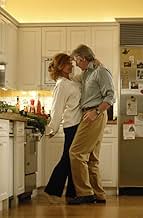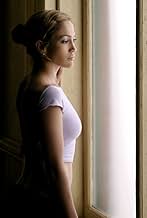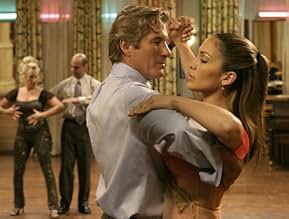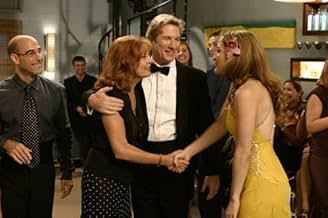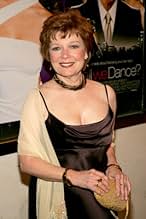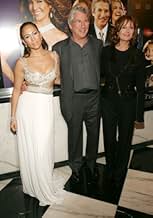Un abogado con una vida aburrida se apunta a clases de baile de salón tras echar el ojo a la bella profesora.Un abogado con una vida aburrida se apunta a clases de baile de salón tras echar el ojo a la bella profesora.Un abogado con una vida aburrida se apunta a clases de baile de salón tras echar el ojo a la bella profesora.
- Dirección
- Guión
- Reparto principal
- Premios
- 7 nominaciones en total
- Vern
- (as Omar Miller)
- Perky Girl
- (as Keti Virshilas)
Reseñas destacadas
"Shall We Dance?" is a delightful entertainment. It is pleasant to see a nice cast like the sexy Jennifer Lopez, the charming Richard Gere, the surprisingly great dancer Stanley Tucci, the funny Lisa Ann Walter, the wonderful Susan Sarandon and excellent support actors and actresses playing and dancing great music along 106 minutes. After watching this feel-good romance, the viewer will certainly feel lighter and relaxed. My vote is seven.
Title (Brazil): "Dança Comigo?" ("Dance With Me?")
Obs: On October 15th 2005, I saw the original "Shall We Dansu?", which is better and better than this remake.
The Hollywood remake, while not as good as the Japanese original, is at least passing grade, in capturing the essence of the film, 'a man seeking not so much a woman as an answer to his question. Why is she sad? What is she thinking' (Ebert, on 'Shall We Dansu', NOT 'Shall We Dance'), as well as everybody's passion for ballroom dancing.
Richard Gere continues to exude his charm on the female audience. Jennifer Lopez, following Maid in Manhattan, continues to get more comfortable with more matured roles. Oscar best actress (and 5 times nominee) Susan Sarandon is dependable as ever. I'm trying very hard to think of a movie in which I can't find Stanley Tucci and darn it, the more I watch the guy, the more I like him!
The main character John Clark seems to be having a great relationship with his wife. But he feels like he can not tell his wife about him taking lessons. The reasoning behind this is unclear, but it seems like he will cheat on his wife with the dance instructor. Of course after watching the movie you see he doesn't commit such an act. In the scene where he travels home everyday on the train and passes the dance studio is very affective. We are uncertain if he will follow through and end up taking the lessons.
When John finally starts dance lessons he really isn't that great. He hides it from everyone at home and work. His family starts to see strange behaviors in him, such as peeking in on him in his room and he is dancing around by himself. They are curious to know what he has been up to; his wife goes on and hires a private investigator to see if he is cheating on her. He then follows John and sees he goes to dance classes.
The best scene in the movie is when John has to perform in the dance competition. He realizes he is really good at something and debates sharing it with his family. When his wife and daughter found out, they went to his dance competition. He messed up when he saw them and his daughter yelled "yeah dad." His family then walked out on him and his performance. From that moment he decided he didn't want to dance anymore. His wife wouldn't let him do that because she saw how good he was!
That said, this edition of "Shall we Dance" directed by Peter Chelsom, is not a horrible movie, but the freshness and subtleness of its Japanese model was lost in the translation. While the Japanese version was light and captivating, this adaptation is a bit heavy handed. The editing of the film has a lot to do with out enjoyment, and when the dance sequences in the competition are clumsily handled as it's the case here, one wonders what could the creators have been looking at?
The idea of seeing Richard Gere as the man who is intrigued by the dancing he sees as he passes the dance academy, is not as credible as one would have expected to be. Mr. Gere is versatile enough as he already showed with his role in "Chicago". The idea of his character pulling the wool over his wife Beverly's eyes doesn't come across as too credible. It seems to be a cultural difference that a Japanese wife might be less vocal and accepting a straying husband than in this country by an American wife. That's basically the fatal flaw with the movie, in our humble opinion.
Jennifer Lopez comes across better. As Paulina she shows a professional attitude toward her students, but her chemistry with Richard Gere doesn't create any sparks. Susan Sarandon, as Beverly, the wife who suspects her husband's betrayal, underplays her role with better results than some of her late screen appearances. Stanley Tucci's character is irritating, at best and Lisa Ann Walters does what she can with Bobbie.
Since you probably have seen this version, take a chance and rent the original Japanese film and compare.
¿Sabías que...?
- CuriosidadesRemake of 1996 Japanese movie with the same title, different writer (based on the original), and different director.
- PifiasWhen Richard Gere's character is at home washing his SUV, the car is covered in soap suds but the driver's window is wide open.
- Citas
Beverly Clark: We need a witness to our lives. There's a billion people on the planet... I mean, what does any one life really mean? But in a marriage, you're promising to care about everything. The good things, the bad things, the terrible things, the mundane things... all of it, all of the time, every day. You're saying 'Your life will not go unnoticed because I will notice it. Your life will not go un-witnessed because I will be your witness'."
- ConexionesEdited into Shall We Dance?: Deleted Scenes (2005)
- Banda sonoraShall We Dance?
(1951)
Music by Richard Rodgers
Lyrics by Oscar Hammerstein II
Produced and Arranged by John Altman
Selecciones populares
- How long is Shall We Dance??Con tecnología de Alexa
Detalles
Taquilla
- Presupuesto
- 50.000.000 US$ (estimación)
- Recaudación en Estados Unidos y Canadá
- 57.890.460 US$
- Fin de semana de estreno en EE. UU. y Canadá
- 11.600.000 US$
- 17 oct 2004
- Recaudación en todo el mundo
- 170.128.460 US$
- Duración
- 1h 46min(106 min)
- Color
- Mezcla de sonido
- Relación de aspecto
- 1.85 : 1




